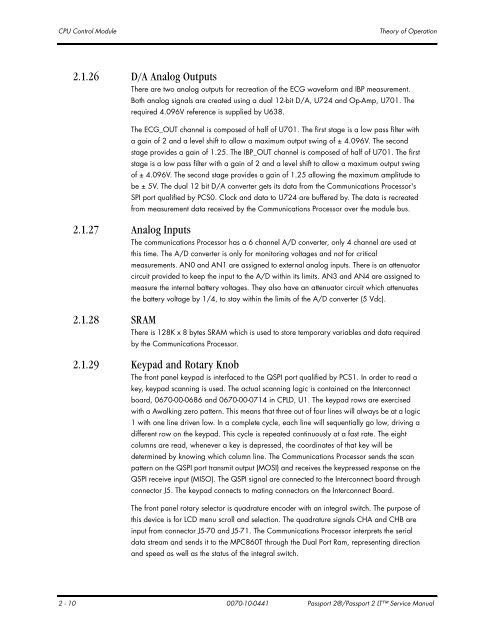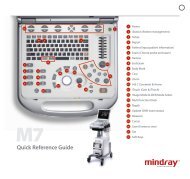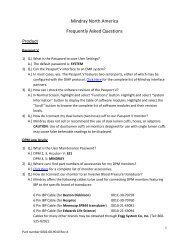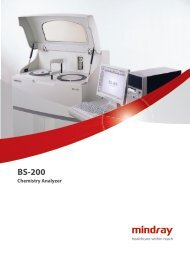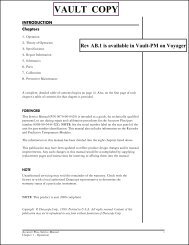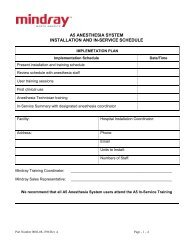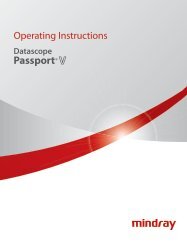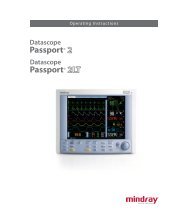Datascope Passport - Mindray
Datascope Passport - Mindray
Datascope Passport - Mindray
Create successful ePaper yourself
Turn your PDF publications into a flip-book with our unique Google optimized e-Paper software.
CPU Control Module Theory of Operation<br />
2.1.26 D/A Analog Outputs<br />
There are two analog outputs for recreation of the ECG waveform and IBP measurement.<br />
Both analog signals are created using a dual 12-bit D/A, U724 and Op-Amp, U701. The<br />
required 4.096V reference is supplied by U638.<br />
The ECG_OUT channel is composed of half of U701. The first stage is a low pass filter with<br />
a gain of 2 and a level shift to allow a maximum output swing of ± 4.096V. The second<br />
stage provides a gain of 1.25. The IBP_OUT channel is composed of half of U701. The first<br />
stage is a low pass filter with a gain of 2 and a level shift to allow a maximum output swing<br />
of ± 4.096V. The second stage provides a gain of 1.25 allowing the maximum amplitude to<br />
be ± 5V. The dual 12 bit D/A converter gets its data from the Communications Processor's<br />
SPI port qualified by PCS0. Clock and data to U724 are buffered by. The data is recreated<br />
from measurement data received by the Communications Processor over the module bus.<br />
2.1.27 Analog Inputs<br />
2.1.28 SRAM<br />
The communications Processor has a 6 channel A/D converter, only 4 channel are used at<br />
this time. The A/D converter is only for monitoring voltages and not for critical<br />
measurements. AN0 and AN1 are assigned to external analog inputs. There is an attenuator<br />
circuit provided to keep the input to the A/D within its limits. AN3 and AN4 are assigned to<br />
measure the internal battery voltages. They also have an attenuator circuit which attenuates<br />
the battery voltage by 1/4, to stay within the limits of the A/D converter (5 Vdc).<br />
There is 128K x 8 bytes SRAM which is used to store temporary variables and data required<br />
by the Communications Processor.<br />
2.1.29 Keypad and Rotary Knob<br />
The front panel keypad is interfaced to the QSPI port qualified by PCS1. In order to read a<br />
key, keypad scanning is used. The actual scanning logic is contained on the Interconnect<br />
board, 0670-00-0686 and 0670-00-0714 in CPLD, U1. The keypad rows are exercised<br />
with a Awalking zero pattern. This means that three out of four lines will always be at a logic<br />
1 with one line driven low. In a complete cycle, each line will sequentially go low, driving a<br />
different row on the keypad. This cycle is repeated continuously at a fast rate. The eight<br />
columns are read, whenever a key is depressed, the coordinates of that key will be<br />
determined by knowing which column line. The Communications Processor sends the scan<br />
pattern on the QSPI port transmit output (MOSI) and receives the keypressed response on the<br />
QSPI receive input (MISO). The QSPI signal are connected to the Interconnect board through<br />
connector J5. The keypad connects to mating connectors on the Interconnect Board.<br />
The front panel rotary selector is quadrature encoder with an integral switch. The purpose of<br />
this device is for LCD menu scroll and selection. The quadrature signals CHA and CHB are<br />
input from connector J5-70 and J5-71. The Communications Processor interprets the serial<br />
data stream and sends it to the MPC860T through the Dual Port Ram, representing direction<br />
and speed as well as the status of the integral switch.<br />
2 - 10 0070-10-0441 <strong>Passport</strong> 2®/<strong>Passport</strong> 2 LT Service Manual


